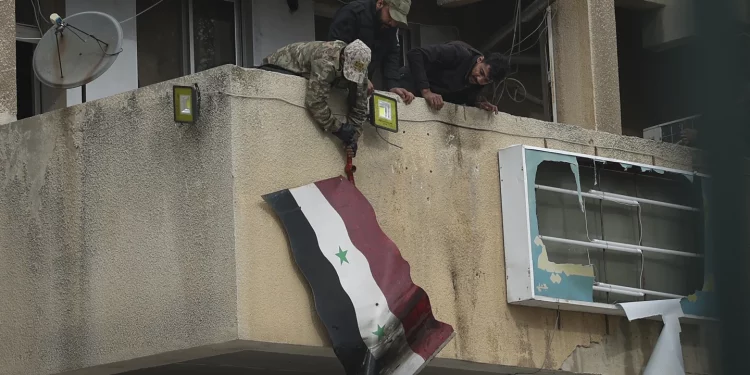Damascus: The Syrian government collapsed early Sunday, falling to a lightning rebel offensive that seized control of the capital of Damascus and sent crowds into the streets to celebrate the end of the Assad family’s 50 years of iron rule.
Syrian state television aired a video statement by a group of men saying that President Bashar Assad had been overthrown and all detainees in jails had been set free.
The man who read the statement said the opposition group known as the Operations Room to Conquer Damascus called on all opposition fighters and citizens to preserve state institutions of “the free Syrian state.”
The statement emerged hours after the head of a Syrian opposition war monitor said Assad had left the country for an undisclosed location, fleeing ahead of insurgents who said they had entered Damascus following a remarkably swift advance across the country.
Many of the capital’s residents were in disbelief at the speed at which Assad lost his hold on the country after nearly 14 years of civil war.
As daylight broke over Damascus, crowds gathered to pray in the city’s mosques and to celebrate in the squares, chanting “God is great.” People also chanted anti-Assad slogans and honked car horns.
In the streets, teen boys picked up weapons that had apparently been discarded by security forces and fired them in the air.
Soldiers and police officers left their posts and fled, and looters broke into the headquarters of the Ministry of Defense. Videos from Damascus showed families wandering into the presidential palace, with some emerging carrying stacks of plates and other household items.
“I did not sleep last night, and I did not accept to sleep until I heard the news of his fall,” said Mohammed Amer Al-Oulabi, 44, who works in the electricity sector. “From Idlib to Damascus, it only took them (the opposition forces) a few days, thank God. May God bless them, the heroic lions who made us proud.”
Meanwhile, organizations that had previously been close to Assad’s government attempted to distance themselves from it.
Syria’s al-Watan newspaper, which was historically pro-government, wrote: “We are facing a new page for Syria. We thank God for not shedding more blood. We believe and trust that Syria will be for all Syrians.”
The newspaper added that media workers should not be blamed for publishing government statements in the past.
“We only carried out the instructions and published the news they sent us,” it said. “It quickly became clear now that it was false.”
A statement from the Alawite sect — to which Assad belongs and which has formed the core of his base — called on young Syrians to be “calm, rational and prudent and not to be dragged into what tears apart the unity of our country.”
“We were and still are advocates of peace and advocates of unity,” it said. The statement called for “the language of reason and dialogue to prevail over all parties in the service of Syria and its great people.”
Syrian Prime Minister Mohammed Ghazi Jalali said in a video statement that the government was ready to “extend its hand” to the opposition and turn its functions over to a transitional government.
He later told Saudi television network Al-Arabiyya that he did not know where Assad and the defence minister were. He said he lost communication with Assad late Saturday.
Rami Abdurrahman of the Syrian Observatory for Human Rights told The Associated Press that Assad took a flight Sunday from Damascus.
State television in Iran, Assad’s main backer in the years of war in Syria, reported that Assad had left the capital. It cited Qatar’s Al Jazeera news network for the information and did not elaborate.
Opposition forces had not reached Damascus since 2018 when Syrian troops recaptured areas on the outskirts of the capital following a yearslong siege.
The night before, opposition forces took the central city of Homs, Syria’s third largest, as government forces abandoned it. The city stands at an important intersection between Damascus, the capital, and Syria’s coastal provinces of Latakia and Tartus — the Syrian leader’s base of support and home to a Russian strategic naval base.
The rebels had already seized the cities of Aleppo and Hama, as well as large parts of the south, in a fast-moving offensive that began November 27.
The advances in the past week were by far the largest in recent years by opposition factions, led by a group that has its origins in al-Qaida and is considered a terrorist organization by the US and the United Nations. In their push to overthrow Assad’s government, the insurgents, led by the Hayat Tahrir al-Sham group, or HTS, have met little resistance from the Syrian army.
HTS controls much of northwest Syria and in 2017 set up a “salvation government” to run day-to-day affairs in the region. In recent years, HTS leader Abu Mohammed al-Golani has sought to remake the group’s image, cutting ties with al-Qaida, ditching hard-line officials and vowing to embrace pluralism and religious tolerance.
“Golani has made history and sparked hope among millions of Syrians,” said Dareen Khalifa, a senior adviser with the International Crisis Group and an expert on Syrian groups. “But he and the rebels now face a formidable challenge ahead. One can only hope they rise to the occasion.”
The UN’s special envoy for Syria, Geir Pedersen, called Saturday for urgent talks in Geneva to ensure an “orderly political transition.” Speaking to reporters at the annual Doha Forum in Qatar, he said the situation in Syria was changing by the minute. Russian Foreign Minister Sergey Lavrov, whose country is Assad’s chief international backer, said he feels “sorry for the Syrian people.”
The Israeli military said Sunday it has deployed forces in a demilitarized buffer zone along its northern frontier with Syria following the rebel offensive there.
The military, which said it also sent troops to “other places necessary for its defence,” said the deployment was meant to provide security for residents of the Israeli-annexed Golan Heights.
AP






































